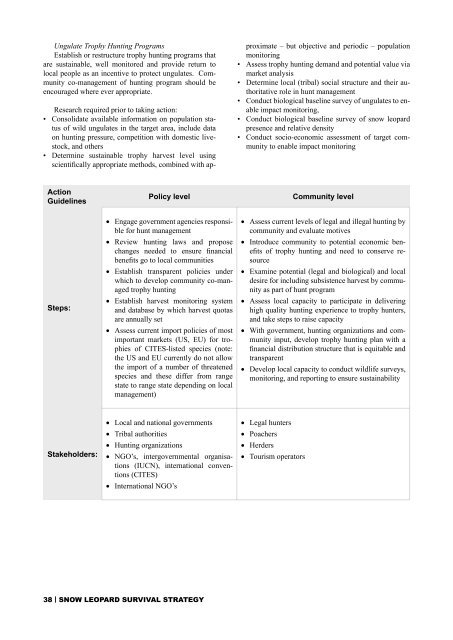Snow Leopard Survival Strategy - Panthera
Snow Leopard Survival Strategy - Panthera
Snow Leopard Survival Strategy - Panthera
Create successful ePaper yourself
Turn your PDF publications into a flip-book with our unique Google optimized e-Paper software.
Ungulate Trophy Hunting Programs<br />
Establish or restructure trophy hunting programs that<br />
are sustainable, well monitored and provide return to<br />
local people as an incentive to protect ungulates. Community<br />
co-management of hunting program should be<br />
encouraged where ever appropriate.<br />
Research required prior to taking action:<br />
• Consolidate available information on population status<br />
of wild ungulates in the target area, include data<br />
on hunting pressure, competition with domestic livestock,<br />
and others<br />
• Determine sustainable trophy harvest level using<br />
scientifically appropriate methods, combined with approximate<br />
– but objective and periodic – population<br />
monitoring<br />
• Assess trophy hunting demand and potential value via<br />
market analysis<br />
• Determine local (tribal) social structure and their authoritative<br />
role in hunt management<br />
• Conduct biological baseline survey of ungulates to enable<br />
impact monitoring,<br />
• Conduct biological baseline survey of snow leopard<br />
presence and relative density<br />
• Conduct socio-economic assessment of target community<br />
to enable impact monitoring<br />
Action<br />
Guidelines<br />
Policy level<br />
Community level<br />
Steps:<br />
• Engage government agencies responsible<br />
for hunt management<br />
• Review hunting laws and propose<br />
changes needed to ensure financial<br />
benefits go to local communities<br />
• Establish transparent policies under<br />
which to develop community co-managed<br />
trophy hunting<br />
• Establish harvest monitoring system<br />
and database by which harvest quotas<br />
are annually set<br />
• Assess current import policies of most<br />
important markets (US, EU) for trophies<br />
of CITES-listed species (note:<br />
the US and EU currently do not allow<br />
the import of a number of threatened<br />
species and these differ from range<br />
state to range state depending on local<br />
management)<br />
• Assess current levels of legal and illegal hunting by<br />
community and evaluate motives<br />
• Introduce community to potential economic benefits<br />
of trophy hunting and need to conserve resource<br />
• Examine potential (legal and biological) and local<br />
desire for including subsistence harvest by community<br />
as part of hunt program<br />
• Assess local capacity to participate in delivering<br />
high quality hunting experience to trophy hunters,<br />
and take steps to raise capacity<br />
• With government, hunting organizations and community<br />
input, develop trophy hunting plan with a<br />
financial distribution structure that is equitable and<br />
transparent<br />
• Develop local capacity to conduct wildlife surveys,<br />
monitoring, and reporting to ensure sustainability<br />
Stakeholders:<br />
• Local and national governments<br />
• Tribal authorities<br />
• Hunting organizations<br />
• NGO’s, intergovernmental organisations<br />
(IUCN), international conventions<br />
(CITES)<br />
• International NGO’s<br />
• Legal hunters<br />
• Poachers<br />
• Herders<br />
• Tourism operators<br />
38 | SNOW LEOPARD SURVIVAL STRATEGY
















